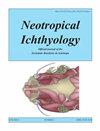Population level genetic divergence and phylogenetic placement of Mexican shortfin mollies (Mollienesia: Poecilia: Poeciliidae)
IF 2
4区 生物学
Q1 ZOOLOGY
引用次数: 2
Abstract
Abstract Mexico is a megadiverse region with a complex geological history, but it remains unclear to what extent the distribution of freshwater fish has been influenced by geographic barriers. This study examines the population level genetic divergence and phylogenetic relationships of species in the shortfin group of the subgenus Mollienesia (genus Poecilia), a group of live-bearing fishes that are widely distributed across Mexico, with sampling at a small geographic scale. Samples from over 50 locations were analyzed for six species by using phylogenetic and haplotype network approaches to assess genetic diversity across geographic ranges and to refine the distributions of species in this group. The results indicate that Mexican species have diversified following multiple, independent invasions from Middle America. Two species found north of the Trans-Mexican Volcanic Belt (TMVB) and one transversal species exhibited weak phylogenetic structure, likely due to the lack of physiographic barriers, recent colonization, and high dispersal rates among regions. In contrast, three species found south of the TMVB exhibited strong phylogenetic structure, reflecting a longer presence in the area and multiple physiographic barriers that isolated populations. This study identified mechanisms driving divergence and speciation, expanded the known range of several species, and resolved taxonomic uncertainties of populations.墨西哥短鳍鳉的种群水平遗传分化及系统发育定位(鳉亚目:鳉科)
墨西哥是一个具有复杂地质历史的物种多样性丰富的地区,但目前尚不清楚淡水鱼的分布在多大程度上受到地理障碍的影响。本研究对广泛分布于墨西哥的Mollienesia亚属(Poecilia属)短鳍鱼群的种群水平遗传分化和物种系统发育关系进行了研究,并在小地理范围内进行了采样。利用系统发育和单倍型网络方法对来自50多个地点的6个物种的样本进行了分析,以评估不同地理范围的遗传多样性,并完善了该类群的物种分布。结果表明,墨西哥物种在中美洲的多次独立入侵后已经多样化。在跨墨西哥火山带(TMVB)北部发现的两个物种和一个横向物种表现出较弱的系统发育结构,可能是由于缺乏地理屏障,最近的殖民化和区域间的高分散率。相比之下,在TMVB以南发现的三个物种表现出较强的系统发育结构,反映了该地区存在的时间较长,以及将种群隔离的多种地理屏障。本研究确定了分化和物种形成的机制,扩大了一些物种的已知范围,并解决了种群分类的不确定性。
本文章由计算机程序翻译,如有差异,请以英文原文为准。
求助全文
约1分钟内获得全文
求助全文
来源期刊

Neotropical Ichthyology
生物-动物学
CiteScore
2.80
自引率
17.60%
发文量
24
审稿时长
6-12 weeks
期刊介绍:
Neotropical Ichthyology is the official journal of the Sociedade Brasileira de Ictiologia (SBI). It is an international peer-reviewed Open Access periodical that publishes original articles and reviews exclusively on Neotropical freshwater and marine fishes and constitutes an International Forum to disclose and discuss results of original research on the diversity of marine, estuarine and freshwater Neotropical fishes.
-Frequency: Four issues per year published only online since 2020, using the ‘rolling pass’ system, which posts articles online immediately as soon as they are ready for publication. A searchable and citable Digital Object Identifier (DOI) is assigned to each article immediately after online publication, with no need to await the issue’s closing.
-Areas of interest: Biology, Biochemistry and Physiology, Ecology, Ethology, Genetics and Molecular Biology, Systematics.
-Peer review process: The Editor-in-Chief screens each manuscript submitted to Neotropical Ichthyology to verify whether it is within the journal’s scope and policy, presents original research and follows the journal’s guidelines. After passing through the initial screening, articles are assigned to a Section Editor, who then assigns an Associate Editor to start the single blind review process.
 求助内容:
求助内容: 应助结果提醒方式:
应助结果提醒方式:


